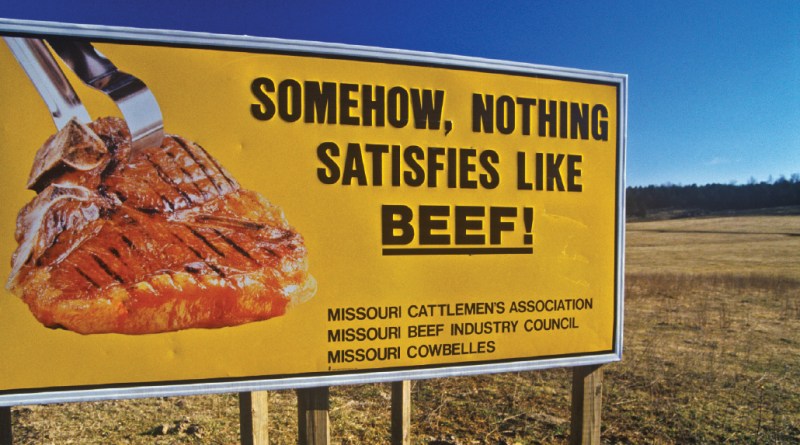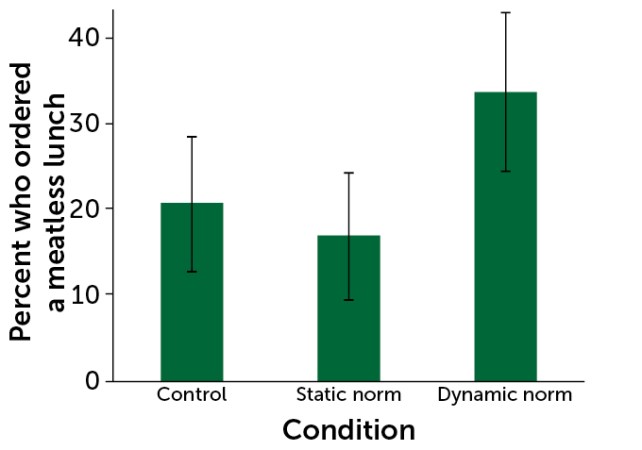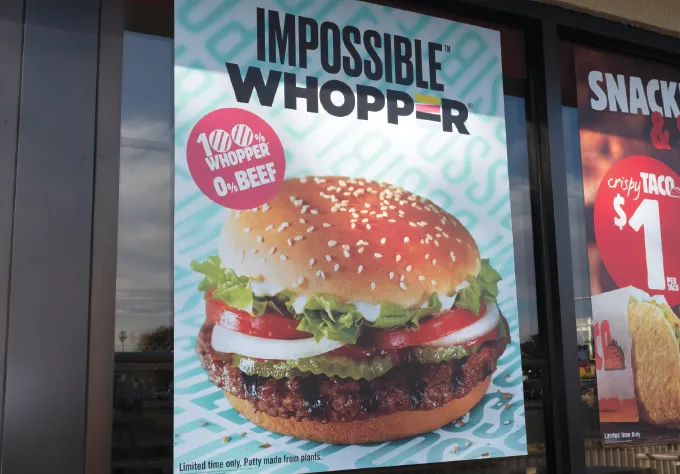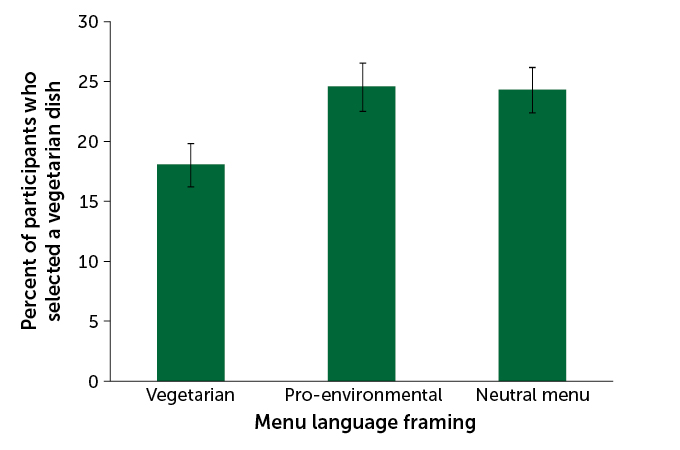Eating meat is the Western norm. But norms can change
How to get people to choose more plant-based foods

It’s going to take some changing of what's considered "normal" to get people to choose fewer processed meats and more plant-based meals.
CLOCKWISE FROM TOP LEFT (ALL VIA GETTY IMAGES): KCLINE/E+; SAVANY/ISTOCK; BERNJUER/ISTOCK; RONDAKIMBROW/ISTOCK; YULIIA KORZHAN/ISTOCK; WESTEND61; YALCINSONAT1/ISTOCK; JENA ARDELL/MOMENT; PIDJOE/ISTOCK; DIANAZH/ISTOCK
When my friend Julie Babulski was a freshman in high school in the mid-1990s, she decided to stop eating meat. “I loved animals. I couldn’t see them suffering,” Babulski says. “The fact that it pissed off my mom was an added, happy bonus.”
For her meat-loving family of Polish immigrants, meals frequently featured kielbasa or bacon, Babulski says. Even the sauerkraut had meat. With such limited food options at home, teenage Babulski initially subsisted on starches and salads. Her mom, she says, thought she “was going to straight up die.”
Babulski, now a biologist at Monroe Community College in Rochester, N.Y., eventually learned to eat a more balanced vegetarian diet, including beans, whole grains and the occasional neon orange veggie dog. But, Babulski remembers, her mom still wished she’d give up the madness.
Mom was probably reacting to the fact that eating is a social activity, uniting family, friends and even strangers. Her daughter could no longer enjoy the turkey at Thanksgiving, the traditional Polish meal of fish on Christmas Eve or even the family’s “lazy pierogies” — dumplings filled with noodles, mushrooms and, of course, bits of bacon.
On a societal level, the decision by Babulski and others to go vegetarian can feel threatening to those who view eating animals as quintessentially American. Eating meat is the norm in the United States, says social psychologist Gregg Sparkman of Princeton University. “It’s literally the center of that Norman Rockwell painting.”

Yet Rockwell’s vision of meat as the star of the American meal has big drawbacks. Besides concerns about animal welfare, medical experts have long encouraged people to eat less processed and red meat for health reasons (SN: 11/28/15, p. 9). What is becoming crystal clear is that a meat-heavy diet is also terrible for the planet (SN: 7/7/18, p. 10).
Shifting demand from meat to beans, whole grains, fruits, vegetables, nuts and seeds could have substantial benefits for the climate. In 2018, total greenhouse gas emissions worldwide were almost 49 billion metric tons. That same year, the United Nations Intergovernmental Panel on Climate Change, the IPCC, estimated that if everyone in the world went vegan, eating only plant-based foods, global emissions could drop by roughly 16 percent in a year, or 8 billion tons.
Meanwhile, going vegetarian, a plant-based diet that includes dairy, eggs and the very occasional meat or seafood allowed in IPCC’s definition, resulted in a 6-billion-ton drop. For those reluctant to give up the bacon entirely, the IPCC says a less absolutist approach could still reap big benefits. The panel estimates that a flexitarian diet — reducing meat and dairy consumption by 75 percent — could cut emissions by 5 billion tons.
Individual behavior changes alone cannot fix a supply chain built around the mass production of meat and animal products. But a more recent April report from the IPCC suggests that the world’s wealthiest individuals could substantially decrease emissions through lifestyle changes, such as driving and flying less and eating less meat. That’s because households with incomes in the top 10 percent generate roughly 36 to 45 percent of global emissions, while households with incomes in the bottom 50 percent contribute just 13 to 15 percent. Moreover, wealthier individuals serve as role models. So those who adopt a low-carbon lifestyle can help establish new, more sustainable social norms.
Sign up for our newsletter
We summarize the week's scientific breakthroughs every Thursday.
Social norms are unwritten rules for how to behave in a given group. Norms encourage conformity. If everyone in a group wears clothes, a single member is unlikely to wander outside naked. But if people think that shedding one’s clothing is becoming the new norm, can this encourage others to follow suit? Yes, Sparkman says. “Actions you do … ripple outward and can change others.”
The challenge, he and others say, is sorting out how to encourage that snowball effect to transform really strong social norms, such as eating meat. These scientists are, in a sense, trying to understand how to make the abnormal appear normal. What would it take, for instance, for people to mentally swap Rockwell’s Thanksgiving turkey for something greener?
Changing normal
Social norms, which by design remain relatively stable across time, typically hinder social change. But research shows that people conform not just to present norms but also to perceived future norms, what Sparkman calls “preconformity.” That suggests that reframing the Julie Babulskis among us as trendsetters rather than social deviants could encourage others to conform to their plant-based vision of the future (SN: 2/26/22, p. 24).
In that vein, Sparkman and colleagues have been testing whether giving information on changing, or “dynamic,” norms can shift people’s food choices. In a pilot study, the team surveyed café-goers at Stanford University. When the 304 mostly faculty, staff and graduate students were waiting to order, researchers handed them one of three written statements.
Some participants received a static norm message: “Recent research has shown that 30 percent of Americans make an effort to limit their meat consumption.” Some participants got a dynamic norm statement: “Recent research has shown that, over the last five years, 30 percent of Americans have started to make an effort to limit their meat consumption.” Participants in a control group read that people are starting to limit the time they spend on Facebook. While the static statement emphasizes change in the present, the dynamic statement emphasizes changes happening over time and theoretically into the future, Sparkman says.
Roughly 20 percent of participants in the control and static norm groups went on to order a meatless lunch in the café compared with 34 percent of participants in the dynamic norm condition, the team reported in 2017 in Psychological Science. The results suggest people’s values can shift, Sparkman says.
Eye to the future
Café-goers who read that meat-eating is decreasing over time, the dynamic norm group, were more likely to order a vegetarian meal than those who read that some Americans limit their meat intake, a static norm, and the controls, who got an irrelevant message.
Messaging affects meatless lunch orders

Group dynamics
As Babulski grew older, she learned about the health and environmental impacts of meat production. Her resolve to stay vegetarian solidified, and a once-impulsive decision became a way of life.
Babulski now shares her personal journey with students in her environmental science course. There’s always that student who treats her dietary choices as a personal affront, Babulski says. One student told her: “I’m going to eat three more chickens because you’re vegetarian to make up for the difference.”
People have long used food restrictions as a proxy for group membership. Hindu and Muslim people live side by side in South Asia, for instance, but can identify members of their own group just by noting who eats pork and who eats beef. “Food taboos are to do with establishing both in and out groups,” says Harriet Ritvo, an environmental historian at MIT.
Divisions around food can encourage tribal identities. For instance, Jewish people in Chicago who avoid leavened food during Passover often feel disconnected from their non-Jewish peers, Kaitlin Woolley, a behavioral scientist at Cornell University, and colleagues reported in 2020 in the Journal of Personality and Social Psychology. But that sense of alienation helps them forge stronger connections with their Jewish peers. In a way, the Passover tribe grows stronger.

“In the West … to become a vegetarian is a very conscious choice to deviate from what is socially normal,” says social psychologist Daniel Rosenfeld of UCLA. “To form a community is often a way to buffer against that feeling of social alienation.”
Strong food-based communities help those within the group, but can repel those outside the group, such as Babulski’s chicken-eating student. Research shows that when people identify a certain diet, such as kosher or vegan, with an out-group, they can develop negative attitudes about the diet or avoid those “specialty” foods.
For instance, setting apart vegetarian items and labeling them “vegetarian” on a menu decreased the percentage of nonvegetarians who chose those entrées versus when the options were incorporated into the main menu, researchers reported in 2020 in the Journal of Environmental Psychology.
But there are ways to thwart that us-versus-them mentality, says Michael Schmitt, a social psychologist at Simon Fraser University in Burnaby, Canada. One option is for researchers and policy makers to promote more inclusive labels. For instance, highlighting movement toward a more flexitarian diet does not seem to trigger the same sort of backlash as highlighting movement toward a vegetarian diet, Schmitt says. “That offers people an identity that might be closer to existing norms.”
Subtly changing the food environment to make veggie options, rather than meat, the default is another idea. For instance, simply increasing the availability of vegetarian meals in a university cafeteria from a quarter of the choices to half the choices increased sales of vegetarian entrées by almost 8 percent, researchers reported in 2019 in the Proceedings of the National Academy of Sciences.
Labeling decisions
Three groups of online participants who were meat eaters saw different menus: One menu set vegetarian choices apart and called them “vegetarian,” one labeled them as good for the environment and a third listed vegetarian and nonvegetarian items together. The vegetarian framing was least likely to lead to veggie orders.
Menu descriptions affect food choice

Then there’s the grocery store. Researchers reported in March in PLOS Medicine that moving Easter chocolates away from prominent locations, like the store entrance and end of aisles, in a chain of U.K. grocery stores caused sales of those items to plummet. Compared with 151 stores that stuck with business as usual, 34 stores that moved the candy sold, on average, 21 kilograms less chocolate per week. Assuming the average chocolate Easter bunny weighs about 100 grams, that equals roughly 200 fewer bunnies sold per store each week.
Imagine if U.S. grocery store operators shunted meat to hard-to-find locations, Schmitt says. Changing perceptions of normal requires first envisioning a new normal.
Ripple effects
Given the sheer scope of climate change, how can one person’s actions make a difference?
Using dynamic norms to change behavior hinges on the simple premise that individual actions do, in fact, matter. Research from the sustainability field bears this out. From 2012 to 2015, officials in Connecticut sought to get more people to install solar panels through a program called Solarize Connecticut. At that time, only 0.4 percent of U.S. homeowners had solar panels, making their use outside the ordinary. So volunteers traveled to 58 towns to encourage residents to make the energy switch. Researchers reported in 2018 in Nature that volunteers who had invested in solar panels themselves convinced almost 63 percent more residents to go solar than volunteers who had made no such investment.

Conversely, individual inaction also matters. In a now classic study from the 1960s appearing in the Journal of Personality and Social Psychology, male undergraduate students sat in a room that slowly filled with smoke. When the students were alone, 75 percent of them reported the situation. But when others were in the room and failed to act, only 10 percent of students reported the problem. Doing nothing had become socially acceptable.
In essence, we live in a world filling with smoke and must choose between inaction and action. Why not choose action?
Babulski applies this philosophy to her own teaching. Minus a naysayer or two, many of her students come to realize the power of their individual choices. “You can actually see students over the course of the semester going, ‘Wow, the little things I do actually do add up and make a difference,’ ” Babulski says.
Eventually, perhaps, a future Norman Rockwell will paint a less meat-heavy meal on that American dinner platter: beans, crickets or a plant-based turkey. Imagine that.







